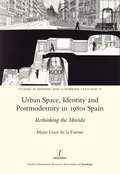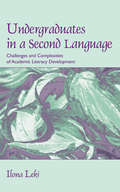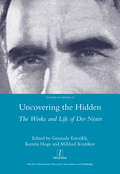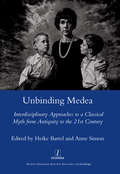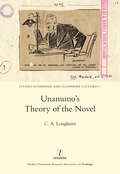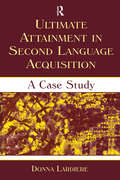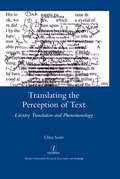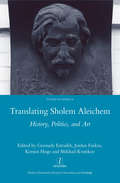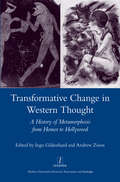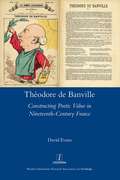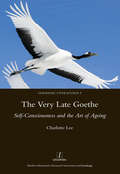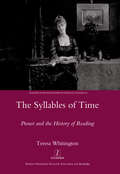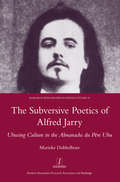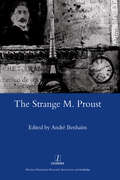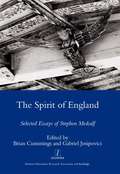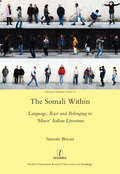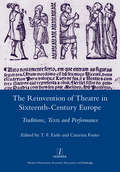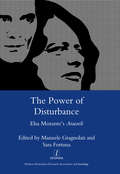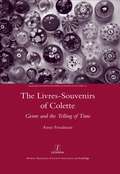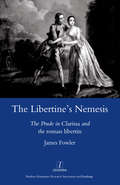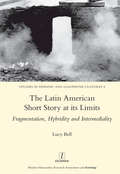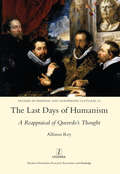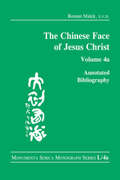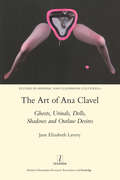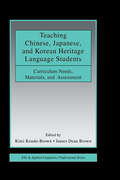- Table View
- List View
Urban Space, Identity and Postmodernity in 1980s Spain: Rethinking the Movida
by MariteUsozdela FuenteDuring the 1980s, the urban youth movement known as la movida transformed the Spanish cultural landscape, particularly in the country's capital, Madrid. After a four-decade long dictatorship, artists and thinkers sought to make the most of their newly found freedoms. The vibrancy, optimism and aesthetic heterogeneity of the period are best captured in contemporary ephemera - in the fanzines and magazines that provided movida participants with an immediate and largely unmediated outlet for their creative experiments. Among them, monthly arts magazine La Luna de Madrid is arguably the most iconic, and its preoccupation with urban space, identity, and postmodernity suggests that la movida was indeed more than 'just a teardrop in the rain', as some of its critics have suggested.
Undergraduates in a Second Language: Challenges and Complexities of Academic Literacy Development
by Ilona LekiThis is the first book-length study of bilingual, international, and immigrant students in English writing courses that attempts to fully embed their writing experiences within the broader frame of their personal histories, the human context of their development, and the disciplinary contexts of their majors. It addresses the questions: How useful are L2 writing courses for the students who are required to take them? What do the students carry with them from these courses to their other disciplinary courses across the curriculum? What happens to these students after they leave ESL, English, or writing classes? Drawing on data from a 5-year longitudinal study of four university students for whom English was not their strongest/primary language, it captures their literacy experiences throughout their undergraduate careers. The intensive case studies answer some questions and raise others about these students’ academic development as it entwined with their social experiences and identity formation and with the ideological context of studying at a US university in the 1990s.
Uncovering the Hidden: The Works and Life of Der Nister
by Gennady EstraikhDer Nister (Pinkhes Kahanovitsh, 1884-1950) is widely regarded as the most enigmatic author in modern Yiddish literature. His pseudonym, which translates as 'The Hidden One', is as puzzling as his diverse body of works, which range from mystical symbolist poetry and dark expressionist tales to realist historical epic. Although part of the Kiev Group of Yiddish writers, which also included David Bergelson and Peretz Markish, Der Nister remained at the margins of the Yiddish literary world throughout his life, mainstream success eluding him both in- and outside the Soviet Union. Yet, to judge from the quantity of recent research and translation work, der Nister is today one of the best remembered Yiddish modernists. The present collection of twelve original articles by international scholars re-examines Der Nister's cultural and literary legacy, bringing to light new aspects of his life and creative output.
Unbinding Medea
by Heike BartelMedea - simply to mention her name conjures up echoes and cross-connections from Antiquity to the present. The vengeful wife, the murderess of her own children, the frail, suicidal heroine, the archetypal Bad Mother, the smitten maiden, the barbarian, the sorceress, the abused victim, the case study for a pathology. For more than two thousand years, she has arrested the eye in paintings, reverberated in opera, called to us from the stage. She demands the most interdisciplinary of study, from ancient art to contemporary law and medicine; she is no more to be bound by any single field of study than by any single take on her character. The contributors to this wide-ranging volume are Brian Arkins, Angela J. Burns, Anthony Bushell, Richard Buxton, Peter A. Campbell, Margherita Carucci, Daniela Cavallaro, Robert Cowan, Hilary Emmett, Edith Hall, Laurence D. Hurst, Ekaterini Kepetzis, Ivar Kvistad, Catherine Leglu, Yixu Lue, Edward Phillips, Elizabeth Prettejohn, Paula Straile-Costa, John Thorburn, Isabelle Torrance, Terence Stephenson, and Amy Wygant.
Unamuno's Theory of the Novel
by C.A. LonghurstMiguel de Unamuno (1864-1936) is widely regarded as Spain's greatest and most controversial writer of the first half of the twentieth century. Professor of Greek, and later Rector, at the University of Salamanca, and a figure with a noted public profile in his day, he wrote a large number of philosophical, political and philological essays, as well as poems, plays and short stories, but it is his highly idiosyncratic novels, for which he coined the word nivola, that have attracted the greatest critical attention. Niebla (Mist, 1914) has become one of the most studied works of Spanish literature, such is the enduring fascination which it has provoked. In this study, C. A. Longhurst, a distinguished Unamuno scholar, sets out to show that behind Unamuno's fictional experiments there lies a coherent and quasi-philosophical concept of the novelesque genre and indeed of writing itself. Ideas about freedom, identity, finality, mutuality and community are closely intertwined with ideas on writing and reading and give rise to a new and highly personal way of conceiving fiction.
Ultimate Attainment in Second Language Acquisition: A Case Study
by Donna LardiereThe first book-length treatment of its type, Ultimate Attainment in Second Language Acquisition is a case study with a solid theoretical grounding that examines the language of an immigrant learner of English, and thereby presents a much needed understanding of the linguistic competence of second language speakers. Based on longitudinal data collected over a period of 16 years, this clear and accessible presentation is well-grounded in linguistic theory and in second language acquisition research issues. Author Donna Lardiere presents the narrative of Patty, an adult Chinese immigrant learner of English, who achieves native-like proficiency in some areas of her English idiolect, although reaches a plateau in her language acquisition, known as the concept of fossilization. By addressing this concept, a central idea in second language acquisition research, Lardiere fills a void in existing literature. Individual chapters focus on Patty’s end state knowledge of grammatical areas of finiteness, past-tense marking, word order, wh-movement and relativization, passivization, number marking, and use of determiners. Important topics discussed throughout the book include:*learner variability in production;*case study methodology;*the roles of motivation and prior language (L1) knowledge; and*sensitivity to input in circumscribing ultimate attainment in adult second language acquisition. Ultimate Attainment in Second Language Acquisition is intended for anyone whose research is in the areas of second language acquisition, language acquisition, theoretical, applied, or developmental linguistics. It is also appropriate for graduate level students of TESOL and teachers who work with more advanced learners of foreign languages.
Translating the Perception of Text: Literary Translation and Phenomenology
by Clive ScottTranslation often proceeds as if languages already existed, as if the task of the translator were to make an appropriate selection from available resources. Clive Scott challenges this tacit assumption. If the translator is to do justice to himself/herself as a reader, if the translator is to become the creative writer of his/her reading, then the language of translation must be equal to the translators perceptual experience of, and bodily responses to, source texts. Each renewal of perceptual and physiological contact with a text involves a renewal of the ways we think language and use our expressive faculties (listening, speaking, writing). Phenomenology and particularly the phenomenology of Merleau-Ponty underpins this new approach to translation. The task of the translator is tirelessly to develop new translational languages, ever to move beyond the bilingual into the multilingual, and always to remember that language is as much an active instrument of perception as an object of perception. Clive Scott is Professor Emeritus of European Literature at the University of East Anglia, and a Fellow of the British Academy.
Translating Sholem Aleichem: History, Politics and Art
by Gennady EstraikhSholem Aleichem, whose 150th anniversary was commemorated in March 2009, remains one of the most popular Yiddish authors. But few people today are able to read the original. Since the 1910s, however, Sholem Aleichem's works have been known to a wider international audience through numerous translations, and through film and theatre adaptations, most famouslyFiddler on the Roof. This volume examines those translations published in Europe, with the aim of investigating how the specific European contexts might have shaped translations of Yiddish literature. With the contributions: Olga Litvak- Found in Translation: Sholem Aleichem and the Myth of the Ideal Yiddish Reader Alexander Frenkel- Sholem Aleichem as a Self-Translator Eugenia Prokop-Janiec- Sholem Aleichem and the Polish-Jewish Literary Audience Gennady Estraikh- Soviet Sholem Aleichem Roland Gruschka- 'Du host zikh a denkmol af eybik geshtelt': The Sovietization and Heroization of Sholem Aleichem in the 1939 Jubilee Poems Mikhail Krutikov- A Man for All Seasons: Translating Sholem Aleichem into Soviet Ideological Idiom Gabriella Safran- Four English Pots and the Evolving Translatability of Sholem Aleichem Sabine Koller- On (Un)Translatability: Sholem Aleichem's Ayznban-geshikhtes (Railroad Stories) in German Translation Alexandra Hoffman- Laughing Matters: Translation and Irony in 'Der gliklekhster in Kodne' Kerstin Hoge- Lost in Marienbad: On the Literary Use of the Linguistic Openness of Yiddish Anna Verschik- Sholem Aleichem in Estonian: Creating a Tradition Jan Schwarz- Speaking Tevye der milkhiker in Translation: Performance, Humour, and World Literature
Transformative Change in Western Thought: A History of Metamorphosis from Homer to Hollywood
by Ingo GildenhardThis groundbreaking volume maps the shifting place and function of marvelous transformations from antiquity to the present day. Shape-shifting, taking animal bodies, miracles, transubstantiation, alchemy, and mutation recur and echo throughout ancient and modern writing and thinking and continue in science fiction today as tales of gene-splicing and hybridisation. The idea of metamorphosis lies in uneasy coexistence with orderly world views and it is often cast out, or attributed to enemies. Augustine and the church fathers consider shape-shifting ungodly; Enlightenment thinkers suppress alchemy as unscientific; genetically-modified wheat and stem-cell research are stigmatised as unnatural. Yet the very possibility of radical transformation inspires hope just as it frightens. A provocative, theorising, trans-historical history, this book ranges across classics, literature, history, philosophy, theology and anthropology. From Homer and Ovid to Proust and H. P. Lovecraft and through figures from Proteus to Kafka's Fly and toSpiderman, four historical surveys are combined with nine case studies to show the malleable, yet persistent, presence of transformation throughout Western cultural history.
Theodore De Banville: Constructing Poetic Value in Nineteenth-century France
by David EvansTheodore de Banville (1823-1891) was a prolific poet, dramatist, critic and prose fiction writer whose significant contribution to poetic and aesthetic debates in nineteenth-century France has long been overlooked. Despite his profound influence on major writers such as Baudelaire, Rimbaud, Verlaine and Mallarme, Banville polarised critical opinion throughout his fifty-year career. While supporters championed him as a virtuoso of French verse, many critics dismissed his formal pyrotechnics, effervescent rhythms and extravagant rhymes as mere clowning. This book explores how Banville's remarkably coherent body of verse theory and practice, full of provocative energy and mischievous humour, shaped debates about poetic value and how to identify it during a period of aesthetic uncertainty caused by diverse social, economic, political and artistic factors. It features a detailed new reading of Banville's most infamous and misunderstood text, the Petit Traitede poesie francaise, as well as extended analyses of verse collections such as Les Stalactites, Odes funambulesques, Les Exiles, Trente-six Ballades and Rondels, illuminated by wide reference to Banville's plays, fiction and journalism. Evans elucidates not only aesthetic tensions at the heart of nineteenth-century French verse, but also a centuries-old tension between verse mechanisms and an unquantifiable, mysterious and elusive poeticity which emerges as one of the defining narratives of poetic value from the Middle Ages, via the Grands Rhetoriqueurs and Dada, to the experiments of the OuLiPo and beyond.
The Very Late Goethe: Self-Consciousness and the Art of Ageing
by Charlotte LeeGoethe's career was an unusually long and productive one: he became a literary celebrity in the 1770s and remained so until his death in 1832. The distinguishing feature of his last works is their self-consciousness, their preoccupation both with the business of writing and with personal development. In the first cross-genre study of this period of Goethe's work, Charlotte Lee traces the theme in his last major poems and autobiographical writings, before turning to the two 'giants', 'Wilhelm Meisters Wanderjahre' and 'Faust II'. All these works share a tendency to allude subtly to earlier moments from Goethe's own literary output, but to fashion them into writing which is quite new - even though (or perhaps because) he himself is old. This book seeks to understand the unique perspective of one nearing the end of a long life.
The Syllables of Time: Proust and the History of Reading
by Teresa WhitingtonThis study reveals reading to be one of the main activities to occupy the inhabitants of the world of Marcel Prousts novel A la recherche du temps perdu. Characters do not just read books but have access to the journals and newspapers of a rapidly expanding print industry. They receive letters and postcards from family and friends. The posters of a nascent advertising industry tempt them to spend an evening at the theatre or a holiday by the sea, and new forms of communication, such as telegraphy, enter their lives and require new strategies of deciphering. All human activity is glossed by means of a series of metaphors of reading, extending the readers domain beyond the written text. Through a series of illuminating analyses, Teresa Whitington shows how this web of references builds into a specifically Proustian account of both the outer, social context of reading and the inner, psychological world of the reader. Proust offers a contribution to the history of reading in the France of his own lifetime and suggests that reading is the very condition of the writing of his fiction.
The Subversive Poetics of Alfred Jarry: Ubusing Culture in the Almanachs Du Pere Ubu
by Marieke DubbelboerParadox and provocation were essential features of all of the work of Alfred Jarry (1873-1907). His non-conformist attitude, whether employed to subvert literary or artistic conventions or to scrutinize social and political issues, marked both his literary writing and his view of the world. Nowhere is this more apparent than in the experimental and satirical Almanachs du Pere Ubu (1898 and 1901), which to date have received little critical attention. Jarry's groundbreaking use of collage in these early works, his absurdist humour and his rethinking of literary authorship and artistic originality foreshadow many innovations of twentieth-century art and literature. In this generously illustrated study Marieke Dubbelboer examines key characteristics of Jarry's poetics through an analysis of the Almanachs and addresses their role within the European avant-garde.
The Strange M. Proust
by Andre BenhaimThe strange M. Proust - the narrator, the author, and the embodiment of A la Recherche du Temps perdu - is now so canonical a writer that his very strangeness is easily overlooked. His book made of other books, his epic composed of extraordinary miniatures, his orderly structure where every law is subverted, his chronology where time can be undone and his geography where places can superimpose: in these, and many other ways, Proust continues to astonish even readers who have engaged with him for their entire careers. In this book, arising from the Princeton symposium of 2006, major critics come together to offer provocative readings of a work which is at the same time classical and unusual, French and foreign, familiar and strange. The book is dedicated to the memory of Malcolm Bowie (1943-2007), whose keynote address was one of his last major lectures. Other contributors include David Ellison, Anne Simon, Eugene Nicole, Joseph Brami, Raymonde Coudert, Christie McDonald, Michael Wood and Antoine Compagnon.
The Spirit of England: Selected Essays of Stephen Medcalf
by Stephen MedcalfStephen Medcalf (1937-2006) was an essayist, in the best traditional sense of that calling: a writer not of books but of substantial and justly celebrated essays, widely read in the Times Literary Supplement and elsewhere. Medcalf's abiding question to the world was the Psalmist's: 'What is man that thou art mindful of him?' His was a Blakean sense of Englishness, far from the chocolate-box painting or the television adaptation, and for him the strongest writers were those keenly aware of their roots in the classical, Anglo-Saxon or Celtic past. By gathering together Medcalf's most important work, this volume shows the coherence of his thinking, and of the elusive, complicated literary heritage he celebrated, one which acknowledges the Greco-Roman strain, the Christian strain, the down-to-earth humour and the sly irony. Thirteen substantial essays cover Virgil, the Bible, the English translation of Alfred, Piers Plowman, the 'half-alien culture' of the high Middle Ages, Chaucer's contemporary Thomas Usk, Shakespeare's images of resurrection, Horace and Kipling juxtaposed, G. K. Chesterton, T. S. Eliot's use of Ovid, P. G. Wodehouse, William Golding, John Betjeman, Geoffrey Hill and other writers. The book concludes with perhaps Medcalf's most personal article of all: his account of finding a baby in a phone box on a cold winter's night, which first appeared in the Guardian Christmas Supplement in 2002.
The Somali Within: Language, Race and Belonging in Minor Italian Literature
by Brioni SimoneThe recent histories of Italy and Somalia are closely linked. Italy colonized Somalia from the end of the 19th century to 1941, and held the territory by UN mandate from 1950 to 1960. Italy is also among the destination countries of the Somali diaspora, which increased in 1991 after civil war. Nonetheless, this colonial and postcolonial cultural encounter has often been neglected. Critically evaluating Gilles Deleuze and F�x Guattari�s concept of �minor literature�, as well as drawing on postcolonial literary studies, The Somali Within analyses the processes of linguistic and cultural translation and self-translation, the political engagement with race, gender, class and religious discrimination, and the complex strategies of belonging and unbelonging at work in the literary works in Italian by authors of Somali origins. Brioni proposes that the �minor� Somali Italian connection might offer a major insight into the transnational dimension of contemporary �Italian� literature and �Somali� culture.
The Reinvention of Theatre in Sixteenth-century Europe: Traditions, Texts and Performance
by T.F. EarleThe sixteenth century was an exciting period in the history of European theatre. In the Iberian Peninsula, Italy, France, Germany and England, writers and actors experimented with new dramatic techniques and found new publics. They prepared the way for the better-known dramatists of the next century but produced much work which is valuable in its own right, in Latin and in their own vernaculars. The popular theatre of the Middle Ages gave endless material for reinvention by playwrights, and the legacy of the ancient world became a spur to creativity, in tragedy and comedy. As soon as readers and audiences had taken in the new plays, they were changed again, taking new forms as the first experiments were themselves modified and reinvented. Writers constantly adapted the texts of plays to meet new requirements. These and other issues are explored by a group of international experts from a comparative perspective, giving particular emphasis to one of the great European comic dramatists, the Portuguese Gil Vicente. Tom Earle is King John II Professor of Portuguese at Oxford. Catarina Fouto is a Lecturer in Portuguese at King's College London.
The Power of Disturbance: Elsa Morante's "Aracoeli"
by Sara FortunaAracoeli (1982) was the last novel written by Elsa Morante (1912-85), one of the most significant Italian writers of the twentieth century. The journey, both geographical and memorial, of a homosexual son in search of his dead mother is a first-person narrative that has puzzled many critics for its darkness and despair. By combining scholars from different disciplines and cultural traditions, this volume re-evaluates the esthetical and theoretical complexity of Morante's novel and argues that it engages with crucial philosophical and epistemological questions in an original and profound way. Contributors explore the manifold tensions staged by the novel in connection with contemporary philosophical discourse (from feminist/queer to political theory to psycho-analysis) and authors (such as Emilio Gadda, Pier Paolo Pasolini and Pedro Almodovar). The Power of Disturbance shows that by creating a 'hallucinatory' representation of the relationship between mother and child, Aracoeli questions the classical distinction between subject and object, and proposes an altogether new and subversive kind of writing. Manuele Gragnolati teaches Italian literature at Oxford University, where he is a Fellow of Somerville College. Sara Fortuna teaches philosophy of language at the Universita Guglielmo Marconi in Rome.
The Livres-souvenirs of Colette: Genre and the Telling of Time
by Anne FreadmanThroughout her career, Colette experimented with genre for the purposes of telling stories of her life. The books that resulted, known collectively as her 'livres-souvenirs', are far from being autobiographies in the customary sense. By addressing the need to reconsider the generic issues surrounding autobiographical story-telling, Anne Freadman's study brings the richness of 'the genre question' to the fore, shedding a fresh light on this much-loved body of work. From the vignettes ofLa Maison de Claudineto the note-books ofL'etoile vesper andLe Fanal bleu, from stories of losing to stories of collecting, Colette's memory books take different narrative forms and explore the passing of time in different ways. This book investigates Colette's variegated generic choices as so many ways of 'telling time'.
The Libertine's Nemesis: The Prude in Clarissa and the Roman Libertin
by James FowlerWhat is the role of the prude in the roman libertin? James Fowler argues that in the most famous novels of the genre (by Richardson, Crebillon fils, Laclos and Sade) the prude is not the libertine's victim but an equal and opposite force working against him, and that ultimately she brings retribution for his social, erotic and philosophical presumption. In a word, she is his Nemesis. He is vulnerable to her power because of the ambivalence he feels towards her; she is his ideological enemy, but also his ideal object. Moreover, the libertine succumbs to an involuntary nostalgia for the values of the Seventeenth Century, which the prude continues to embody through the age of Enlightenment. In Crebillon fils and Richardson, the encounter between libertine and prude is played out as a skirmish or duel between two individuals. In Laclos and Sade, the presence of female libertines (the Marquise de Merteuil and Juliette) allows that encounter to be reenacted within a murderous triangle.
The Latin American Short Story at its Limits: Fragmentation, Hybridity and Intermediality
by Lucy BellThe Latin American short story has often been viewed in terms of its relation to orality, tradition and myth. But this desire to celebrate the difference of Latin American culture unwittingly contributes to its exoticization, failing to do justice to its richness, complexity and contemporaneity. By re-reading and re-viewing the short stories of Juan Rulfo, Julio Cortazar and Augusto Monterroso, Bell reveals the hybridity of this genre. It is at once rooted in traditional narrative and fragmented by modern experience; its residual qualities are revived through emergent forms. Crucially, its oral and mythical characteristics are compounded with the formal traits of modern, emerging media: photography, cinema, telephony, journalism, and cartoon art.
The Last Days of Humanism: A Reappraisal of Quevedo's Thought
by Alfonso ReyFrancisco de Quevedo (Madrid, 1580-1645) was well known for his rich and dynamic style, achieved through an ingenious and complex manipulation of language. Yet he was also a consistent and systematic thinker, with moral philosophy, broadly understood, lying at the core of his numerous and varied works. Quevedo lived in an age of transition, with the Humanist tradition on the wane, and his writing expresses the characteristic uncertainty of a moment of cultural transition. In this book Alfonso Rey surveys Quevedo's ideas in such diverse fields as ethics, politics, religion and literature, ideas which hitherto have received little attention. New information is also provided towards a reconstruction of the cultural evolution of Europe in the years prior to the Enlightenment, and thus the scope of the book extends beyond that of Spanish literature.
The Chinese Face of Jesus Christ: Annotated Bibliography: volume 4a (Monumenta Serica Monograph Ser.)
by Roman MalekThis volume provides an annotated bibliography of the Western and Chinese literature on Jesus Christ in China. It is a sequel to the interdisciplinary collection on the manifold faces and images of Jesus throughout Chinese history, from the Tang dynasty (618�907) to the present time.The present bibliography broadens and deepens the above-mentioned subject matter, and also points out aspects which have been addressed in the contributions and anthologies of the previous volumes of The Chinese Face of Jesus Christ, but which have not been treated thoroughly. Another aim of this bibliography is to initiate and enable further research, particularly in China. It includes bibliographical data from the beginning of the introduction of Christianity to China until the year 2013, occasionally also until 2014. A list of �Key References� enables the reader to identify important works on main topics related to Jesus Christ in China. Some examples of book covers and title pages are included in the section of �Illustrations.�Other volumes of the collection The Chinese Face of Jesus Christ are in preparation: Vol. 3c will present longer quotations from the sources listed in the present bibliography, Vol. 4b will contain a general index with glossary, and Vol. 5 will deal with the iconography of Jesus Christ in China.
The Art of Ana Clavel: Ghosts, Urinals, Dolls, Shadows and Outlaw Desires
by JaneElizabeth LaveryAna Clavel is a remarkable contemporary Mexican writer whose literary and multimedia oeuvre is marked by its queerness. The queer is evinced in the manner in which she disturbs conceptions of the normal not only by representing outlaw sexualities and dark desires but also by incorporating into her fictive and multimedia worlds that which is at odds with normalcy as evinced in the presence of the fantastical, the shadow, ghosts, cyborgs, golems and even urinals. Clavels literary trajectory follows a queer path in the sense that she has moved from singular modes of creative expression in the form of literary writing, a traditional print medium, towards other non-literary forms. Some of Clavels works have formed the basis of wider multimedia projects involving collaboration with various artists, photographers, performers and IT experts. Her works embrace an array of hybrid forms including the audiovisual, internet-enabled technology, art installation, (video) performance and photography. By foregrounding the queer heterogeneous narrative themes, techniques and multimedia dimension of Clavels oeuvre, the aim of this monograph is to attest to her particular contribution to Hispanic letters, which arguably is as significant as that of more established Spanish American boom femenino women writers.
Teaching Chinese, Japanese, and Korean Heritage Language Students: Curriculum Needs, Materials, and Assessment (ESL & Applied Linguistics Professional Series)
by Kimmi Kondo-Brown James Dean BrownThis book contributes to building the research knowledge that language teaching professionals need in developing curriculum for the large population of East Asian heritage students (including Chinese, Japanese, and Korean) in countries like the United States, Canada, and Australia, where speakers of East Asian languages are among the fastest growing populations. Heritage learners are defined as those who initially acquired certain levels of linguistic and cultural competence in a non-dominant language mainly through interaction with foreign-born parents and other family members at home. Heritage language instruction is currently a “hot topic” and is becoming a sub-discipline within the fields of foreign language education and applied linguistics. Special instruction for heritage language learners is on the rise, particularly in the U.S. and Canada. Providing theoretical and practical information about heritage-language instruction in terms of curriculum design, learner needs, materials development, and assessment procedures, the goal of this book is not only to promote research about heritage students in East Asian languages but also to improve the teaching of these students in various educational settings and all over the world, especially in English speaking countries. The volume is organized in four sections:*Overview—addressing the timeliness, necessity, and applications of the work and issues and future agendas for teaching Chinese, Japanese, and Korean heritage students;*Language Needs Analysis;*Attitude, Motivation, Identity, and Instructional Preference; and*Curriculum Design, Materials Development, and Assessment Procedures Teaching Chinese, Japanese, and Korean Heritage Language Students is intended as a primary text or reference for researchers, educators, and students in the areas of curriculum, pedagogy, and assessment studies related to teaching bilingual and heritage students in general and East Asian heritage students in particular.
